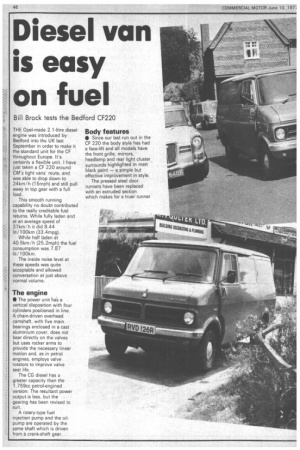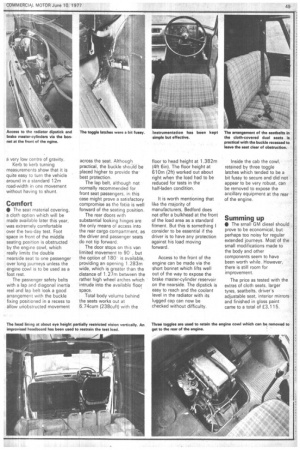Diesel van is easy on fuel
Page 48

Page 49

Page 51

If you've noticed an error in this article please click here to report it so we can fix it.
Bill Brock tests the Bedford CF220
THE Opel-made 2.1-litre diesel engine was introduced by Bedford into the UK last September in order to make it the standard unit for the CF throughout Europe. Its certainly a flexible unit. I have just taken a CF 220 around CM's light vans route, and was able to drop down to 24krn/h (15mph) and still pull away in top gear with a full toad.
This smooth running capability no doubt contributed to the really creditable ftiel returns. While fully laden and at an average speed of 37km/h it did 8.44 lit/100km (33.4rnpg).
While half laden at 40.5km/h (25.2mph) the fuel consumption was 7.87 lit/100km.
The inside noise level at these speeds was quite acceptable and allowed conversation at just above normal volume.
The engine
• The power unit his a vertical disposition with four cylinders positioned in line. A chain-driven overhead camshaft, with five main bearings enclosed in a cast aluminium cover, does not bear directly on the valves but uses rocker arms to provide the necessary linear motion and, as in petrol engines, employs valve rotators to improve valve seat life.
The CO diesel has a greater capacity than the 1,759cc petrol-engined version. The resultant power output is less, but the gearing has been revised to suit A rotary-type fuel injection pump and the oil pump are operated by the same shaft which is driven from a crank-shaft gear.
Body features
II Since our last run out in the CF 220 the body style has had a face-Lift and all models have the front grille, mirrors, headlamp and rear light cluster. surrounds highlighted in matt black paint — a simple but effective improvement in style.
The pressed steel door runners have been replaced with an extruded section which makes for a truer runner and is less likely to jam.
The rubber strips running vertically at the rear of the door opening have been trimmed down to follow the contours of the body more closely. But they still faiI to exclude draughts at all times.
Motorway running
• On the motorway at speeds about 80km/ h (50mph) the incidence of body boom exceeded an acceptable level of noise for the van to be used for long, high-speed journeys on a regular basis. Having said that, the CF is no worse and better than many other panel vans in this respect, but there is a lot of room for improvement to reduce interior noise levels and, ultimately, driver fatigue.
Forward visability was impared to some extent by the low roof-lining which came down to about eye height. This did not appear to be a problem until, when I was leading a stationary queue of traffic at traffic lights, it proved to be impossible to see the red change to green without leaning well forward.
The windscreen wipers swept a good area but left a strip on the nearside unattended, which on a dirty day could result in a 34cm (13in) wide blind spot at the narrowest point when included with the screen pillar.
The facia padding and basic instrument panel were in black while the painted top edge of the facia had been left the same light green colour as the rest of the van which produced a reflection along the lower edge of the screen where none need exist.
During track tests carried out at MIRA on a wet and windy day a deceleration of 0.7g overall was recorded for a maximum brake application at 40mph while pulling up straight.
The park brake gave a peak retardation figure well above the legal requirement at 0.35g, while on the test gradients it was able to hold the van stationary facing both up and down a 1 in 4 incline.
The handling felt good and 'gave no cause for concern when pushed hard around the ever-changing cambers and bends of the ride and handling circuit. Body roll was negligible but it is worth mentioning that the test load is compact and when placed on the load compartment with a floor height of 61cm (2ft) produces a very low centre of gravity.
Kerb to kerb turning measurements show that it is quite easy to turn the vehicle around in a standard 12m road-width in one movement without having to shunt.
Comfort
• The seat material covering, a cloth option which will be made available later this year, was extremely comfortable over the two-day test. Foot space in front of the middle seating position is obstructed by the engine cowl, which really limits the double nearside seat to one passenger over long journeys unless the engine cowl is to be used as a foot rest.
The passenger safety belts with a lap and diagonal inertia reel and lap belt look a good arrangement with the buckle fixing positioned in a recess to allow unobstructed movement across the seat. Although practical, the buckle should be placed higher to provide the best protection.
The lap belt, although not normally recommended for front seat passengers, in this case might prove a satisfactory compromise as the fatia is well forward of the seating position.
The rear doors with substantial looking hinges are the only means of access into the rear cargo compartment, as the driver and passenger seats do not tip forward.
The door stops on this van limited movement to 90 , but the option of 180 is available, providing an opening 1.283m wide, which is greater than the distance of 1.27m between the rather high wheel arches which 'intrude into the available floor space.
Total body volume behind the seats works out at 6.74cum (238cuft) with the floor to head height at 1.382m (4ft 6in). The floor height at 610m (2ft) worked out about right when the load had to be reduced for tests in the half-laden condition.
It is worth mentioning that like the majority of manufacturers, Bedford does not offer a bulkhead at the front of the load area as a standard fitment. But this is something I consider to be essential if the driver is to have any protection against his load moving forward.
Access to the front of the engine can be made via the short bonnet which lifts well out of the way to expose the brake master-cylinder reservoir on the nearside. The dipstick is easy to reach and the coolant level in the radiator with its lugged cap can now be checked without difficulty. Inside the cab the cowl, retained by three toggle latches which tended to be a bit fussy to secure and did not appear to be very robust, can be removed to expose the ancillary equipment at the rear of the engine.
Summing up
• The small GM diesel should prove to be economical, but perhaps too noisy for regular extended journeys. Most of the small modifications made to the body and other components seem to have been worth while. However, there is still room for improvement.
The price as tested with the extras of cloth seats, larger tyres, seatbelts, driver's adjustable seat, interior mirrors and finished in gloss paint came to a total of £3,115.




























































































